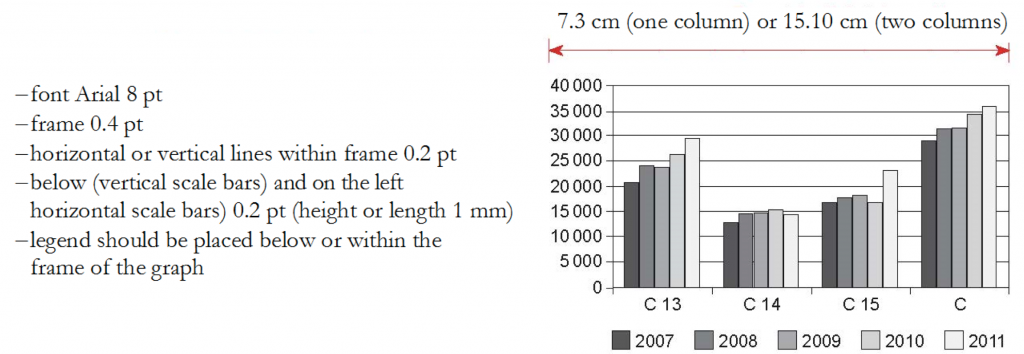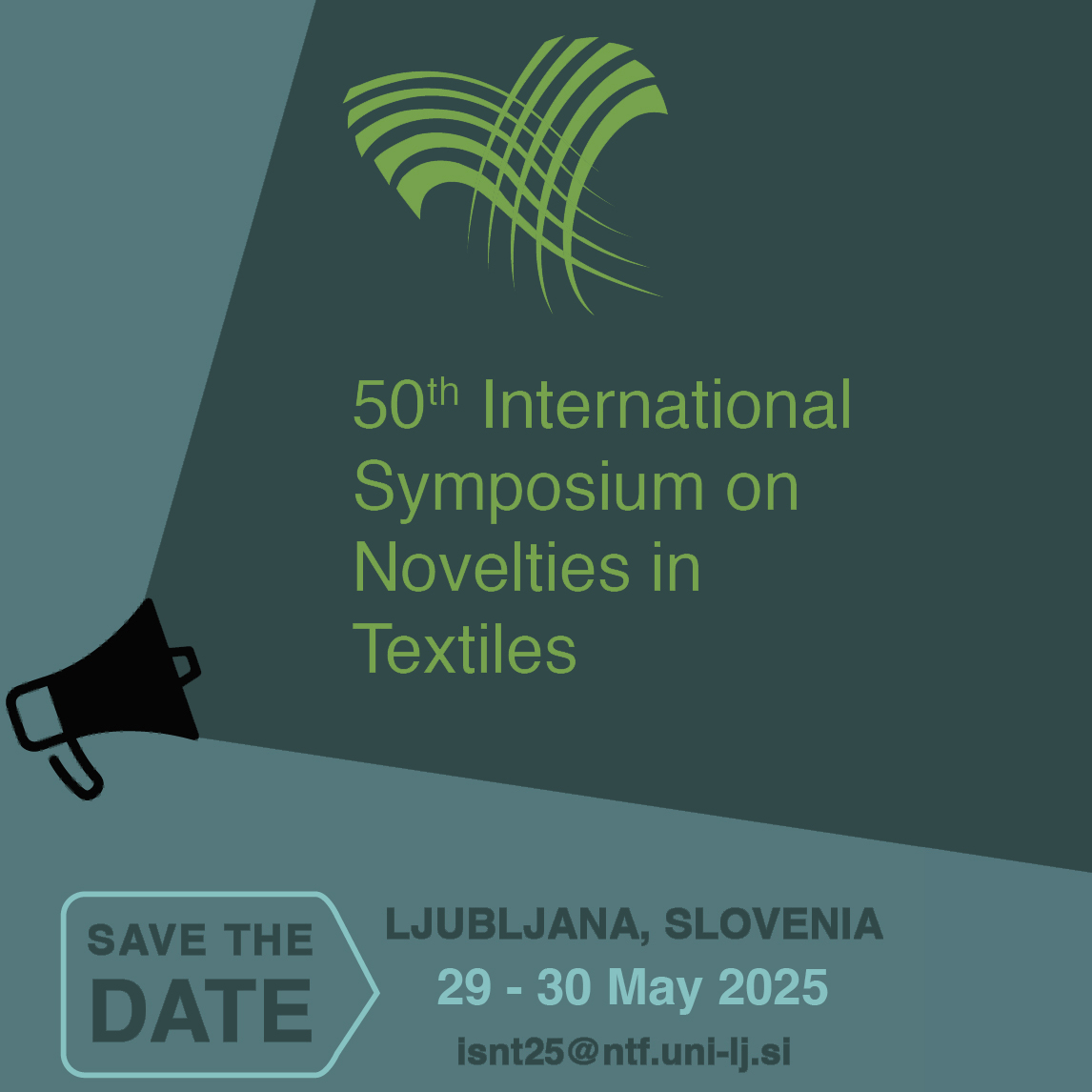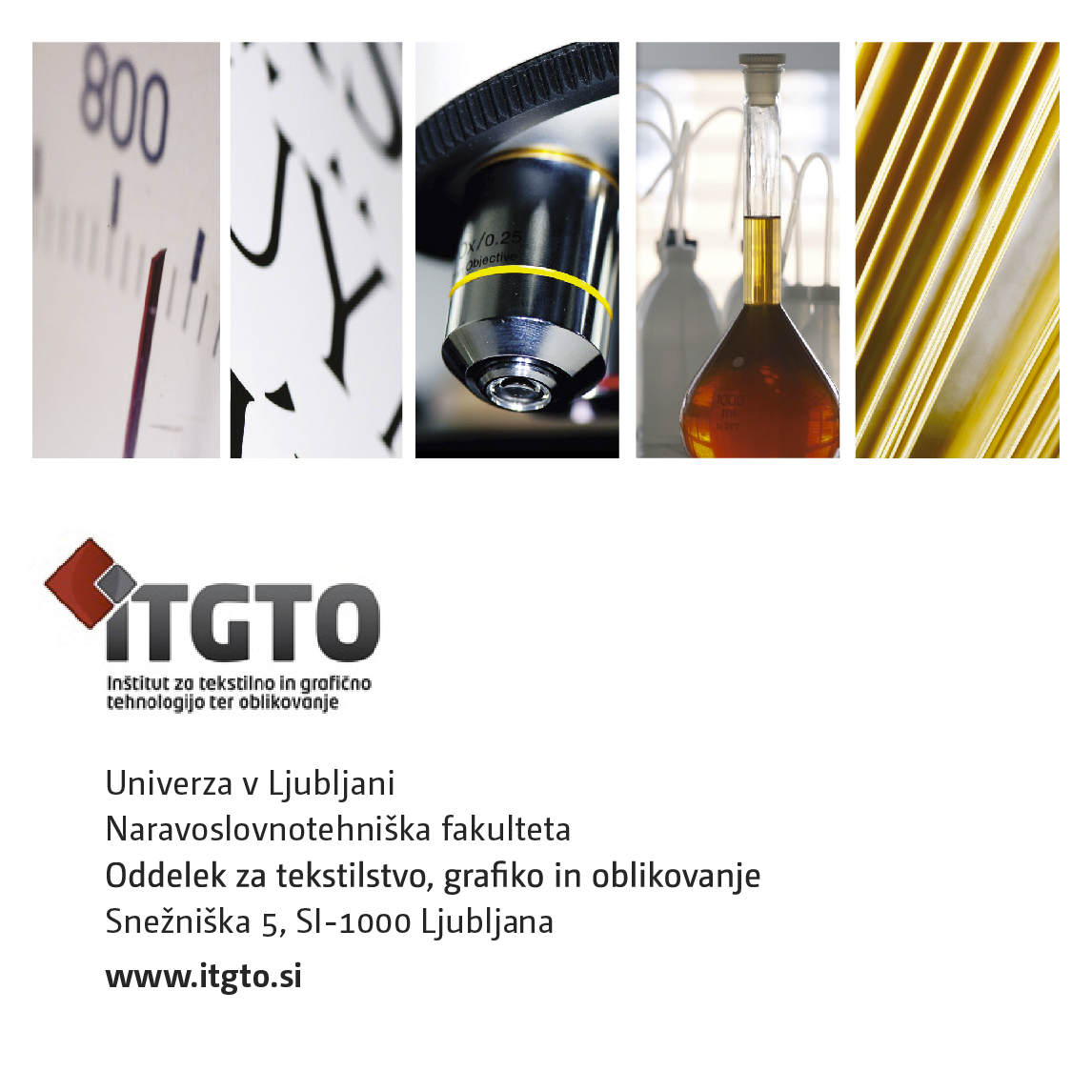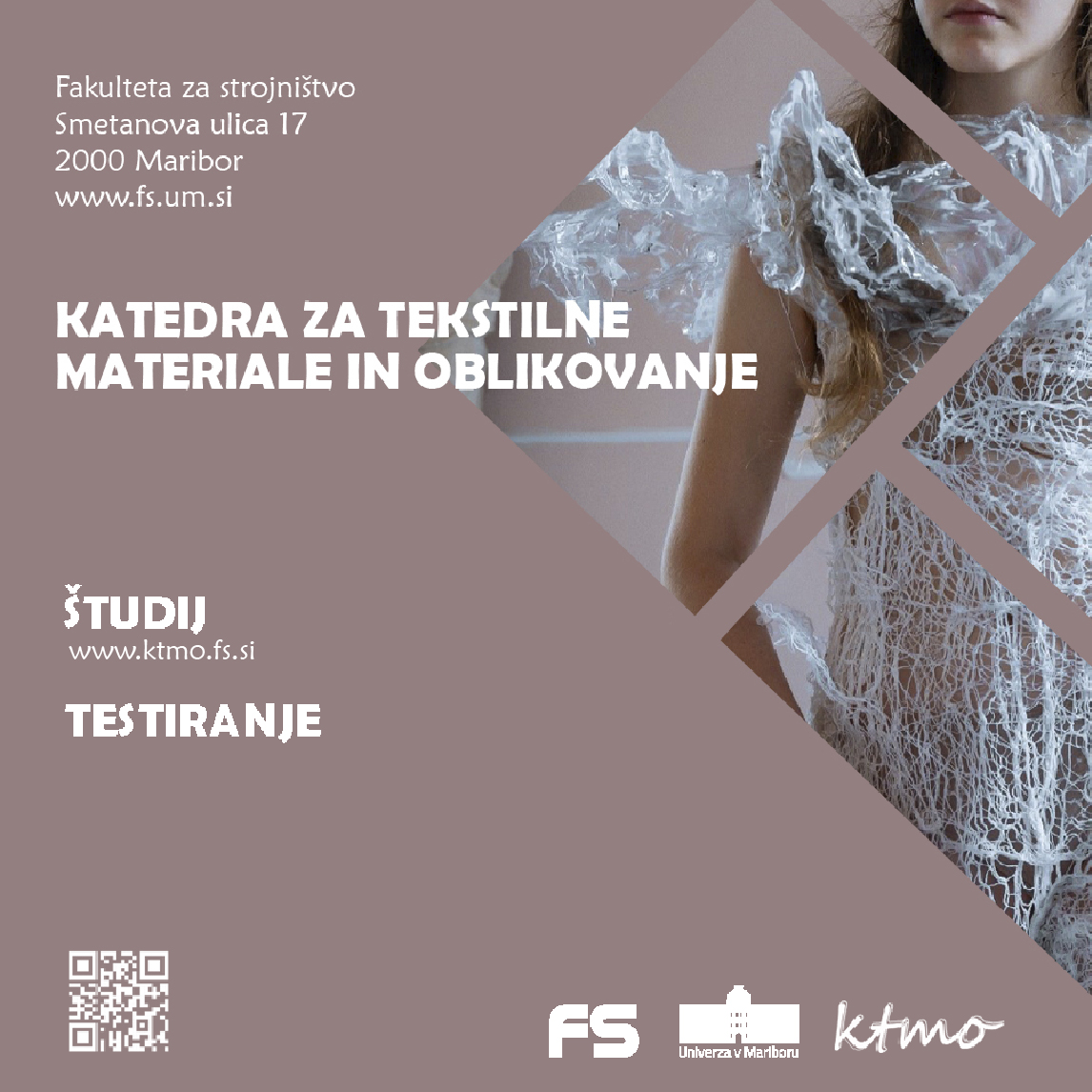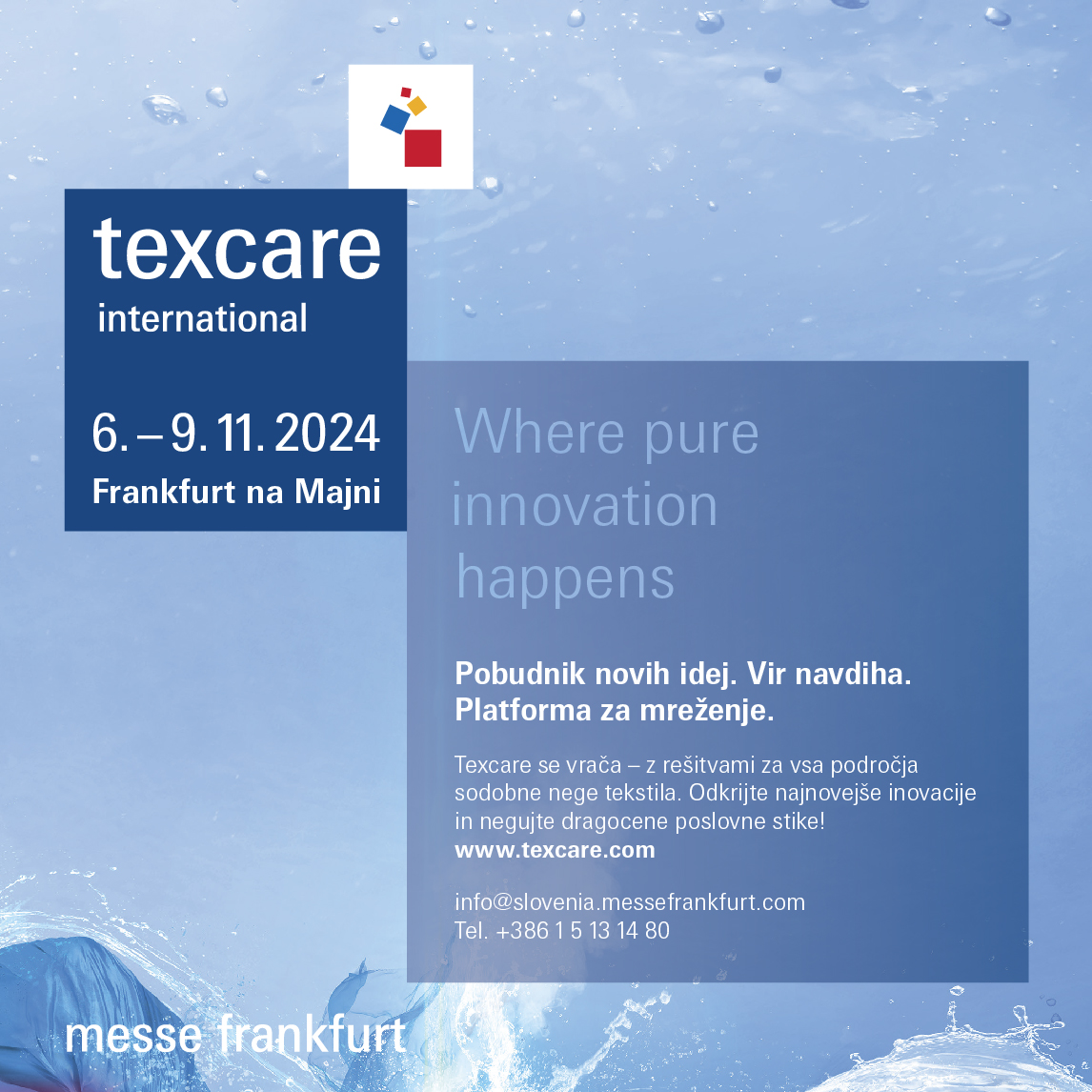Topic covered by journal Tekstilec
The journal Tekstilec publishes scientific, professional and review papers from the field of textile fibres and textile research, chemical and mechanical textile technology, textile care, technical textiles, medical textiles, interior design textiles, clothing technology, protective clothing, clothing comfort, textile and clothing design, ensuring textile and clothing quality, and the use of computer technologies in textiles. The journal also publishes papers from interdisciplinary fields connected with textiles, e.g. marketing, ecology, ergonomics, education etc. Special sections include the novelties in the professional field of textiles at home and abroad, the novelties in the field of standardisation and metrology, in the field of fashion, news from the associations of textile engineers and from the association of the textile and clothing industry at the Chamber of Commerce as well as the information about trade fairs, symposiums and conferences.
Paper categories
Research and professional papers are reviewed and classified in accordance with the typology of articles by the COBISS system into the following categories:
– 1.01 Original Scientific Paper
– 1.02 Scientific Review
– 1.03 Preliminary Communication
– 1.04 Professional Paper.
1.01 Original Scientific Papers are the first publication of original research results in such a form that the research can be repeated and conclusions verified. Scientific information must be demonstrated in such a way that the results are obtained with the same accuracy or within the limits of experimental errors as stated by the author, and that the accuracy of analyses the results are based on can be verified. An original scientific paper is generally designed according to the IMRAD scheme (Introduction, Methods, Results and Discussion) for experimental research or in a descriptive way for descriptive scientific fields, where observations are given in a simple chronological order.
1.02 Scientific Reviews most frequently present an overview of most recent work in a specific field, work of an individual researcher or a team of researchers with the purpose of summarizing, analysing, evaluating or synthesizing information that has already been published. This type of paper brings new syntheses, new ideas and theories, and even new scientific examples. No scheme is prescribed for scientific reviews, as it is the case with original scientific papers.
1.03 Preliminary Communications (preliminary reports) are in fact an original scientific article where some elements of the IMRAD scheme have been omitted. Preliminary communications are short reports about finished original scientific work or work which is still in progress. Letters to the editor of scientific journals and short scientific notes are included in this category as well.
1.04 Professional Papers are presentations of what is already known, with the emphasis on the usability of original research results and the spreading of knowledge. The complexity of the text is adapted to the needs of users and readers of the scientific or professional journal this category of paper is published in. Within the frame of listed categorised papers, we also publish articles which have been submitted as papers at various scientific gatherings and complement or enrich with their topics the journal content.
Professional contributions which are not categorised are:
- reports from scientific symposiums, conferences, consultations,
- presentations and reports from practice (on operation and problems of individual laboratories, institutions or industry) which are informative,
- opinions and comments represent contributions on current affairs and problems in science and textile industry; it is not necessary for the viewpoints and references to be consistent with the viewpoint of the editorial board,
- from foreign press – contributions covering important work, which are published as a supplement to the professional journal content.
Authors may suggest other categories for their publications; however, the final decision is left to the editorial board.
Graphically technical paper preparation
Title, authors: The title should be as short as possible, specific and informative, in order to reflect the paper content. Author’s (Authors’) full name and surname, academic title and address of the institution or company should be written above the paper title (on the left). The proposed paper category and the corresponding author (academic title, name and surname, telephone and e-mail) should be written below the paper title on the left. The title of the paper is to be translated into UK English.
Abstract: Abstracts should be written for original scientific papers, scientific reviews, professional papers and preliminary communications. Abstracts should comprise 200–400 words, giving a succinct account of the work, not only the subheadings and conclusions. An abstract can contain basic research hypotheses, information on work methodology and most relevant results. It should be translated into UK English. The translation is only exceptionally taken over by the editors.
Keywords: At the end of the abstract, below the text, three to five keywords from the paper title and abstract should be listed and translated into UK English.
Text structure: The paper structure should be in compliance with the paper typology as defined by the COBISS system.
The text should be written in Microsoft Word (*.doc or *.docx) in A4 format, leading 1.5, type size 12 pt, title 14 pt, text being justified. The recommended typeface is Times New Roman. For the whole text, no other but style NORMAL should be used. Paragraphs should be separated with one blank line. Only the main chapters and subchapters, respectively, should be numbered consecutively (e.g. 1 Chapter or 2.1 Materials). The subheadings at the third level should be marked in bold.
The text should be written in a clear and concise way. The editors reserve the right to shorten the text if something is repeated several times, if commonly known facts are stated or if superfluous words are used. The paper should be written either in the first person plural or third person singular, despite the author themselves conducting the research. Experimental part should generally follow this structure (cf. IMRAD scheme at original scientific paper): introduction, materials and methods, results with discussion and conclusion. The writing of the paper should spring from the supposition that the readers are already familiar with the basics of the field the paper refers to. The experimental technique and equipment should be described in detail if they significantly deviate from previously published description in the literature; for the techniques and equipment the readers are most likely already familiar with, the sources where additional explanations can be found should be listed.
Tables and figures (schemes, diagrams, graphs, photographs etc) represent a component part of the manuscript. The tables and figures should be comprehensible even if not reading the text of the paper. They are submitted separately from the text; however, the references in the text should be made to tables and figures, in order to approximately define their position in the printed version of the paper (e.g. Measurement results (Table 3) clearly demonstrates …). Figure descriptions (legend) should be written below the figures they refer to. The accompanying figures should be original and prepared by the authors themselves in electronic form.
The text describing tables (table titles) should be written above the tables and numbered consecutively, as should be figures, apart from the text describing figures which should follow below the figures and not above as it is the case with tables.
Figures (schemes, diagrams, graphs etc) should be prepared in graphic programs, as demonstrated by the figure below, and saved in formats: *.pdf, *.ai, *.eps or *.jpg:
Photographs should be saved in the formats *.tif, *.jpg or *.eps (photographs should be prepared in the width of one or two columns). The resolution should be at least 300 dpi. The authors can also send original images or photographs, respectively, to the editors in case the resolution of attachments would not suffice the requirements for a qualitative print.
Mathematical and chemical formulas should be prepared in Microsoft Word Equation. Each formula should have its own successive number written in a round bracket, which is also mentioned within the text, since it is for technical reasons not always possible to locate the formulas to exact places in the article. The authors should write the corresponding numbers of formulas into the text. All special characters used in formulas (Greek letters etc) should be separately explained below the corresponding formula or within the text.
Referencing: The literature used as reference should be listed in the correct order from one onwards, as these references appear in the text. We mark the references with numbers in square brackets (e.g. “According to Morton [3], this phenomenon is …”). The list of references presents an obligatory part of the manuscript and is located at the end of the manuscript. The literature sources should be cited in accordance with the SIST ISO 690:1996 standard (Documentation – Bibliographic references – Content, form and structure). All cited literature sources should have the tag from the CrossRef base added, if the latter exists (DOI – Digital Object Identifier).
The titles of cited literature sources should be written out in full. All information taken from foreign sources should be written in the language of the article; however, the titles of books and referenced articles are not to be translated.
Examples of referencing:
- Articles
- ZAVRŠNIK, Tomaž. Biološko plemenitenje s pomočjo encimov. Tekstilec, 1996, 39(12), 292−299.
- GAMBLIN, Rodger L. Surfactant-enhanced dyeing. Textile Chemist and Colorist, 1996, 28(2), 12−15.
- KOSTAJNŠEK, Klara and DIMITROVSKI, Krste. Multilayer cotton fabric porosity and its influence on permeability properties. Tekstilec, 2013, 56(4), 335−344, doi: 10.14502/Tekstilec2013.56.312–322.
- Books
- PREVORŠEK, Dušan Ciril. Visokozmogljiva vlakna iz gibkih polimerov : teorija in tehnologija. Edited by T. Rijavec and F. Sluga. 1. ed. Ljubljana : Univerza v Ljubljani, Naravoslovnotehniška fakulteta, Oddelek za tekstilstvo, 1998, p. 169−180.
- Wool dyeing. Edited by D. M. Lewis. Bradford : Society of Dyers and Colourists, 1992.
- Contributions in monographs and journals of scientific papers
- CERKVENIK, Janez and NIKOLIĆ, Momir. Prestrukturiranje slovenske tekstilne industrije s stališča tehnološke opremljenosti, porabe energetskih virov in ekologije. In 28. Mednarodni simpozij o novostih v tekstilni tehnologiji in oblikovanju : zbornik predavanj in posterjev. Edited by B. Simončič. Ljubljana : FNT Oddelek za tekstilno tehnologijo, 1994, p. 24−38.
- Patents
- JAKŠIĆ, Danilo. Stroj za izdelavo triaksialne tkanine, SI patent, no. 9500115. 1996-11-04.
- World Wide Web references
- Pattern design software [accessible from a distance]. OptiTex [accessed 29. 9. 2011]. Available on World Wide Web:
<http://www.optitex.com/en/products/main_modules/pattern_design >.
- Standards
- DIN 53884 Gewichtsbestimmungen an Gewirken und Gestrickten. Taschenbuch für die Textilindustrie. Berlin: Fachverlag Schiele & Schön, 2001, 37−43.
Language: The manuscript of submitted papers should be written in UK English and it is the authors responsibility to ensure the quality of the language.
Manuscript length: The manuscript should not exceed 30,000 characters without spacing.
Article submission
The texts should be submitted only in their electronic form in the format *.doc (or *docx) and in the format *.pdf (made in the computer program Adobe Acrobat) to the address: tekstilec@a.ntf.uni-lj.si.
The name of the document should contain the date (year-month-day) and the surname of the corresponding author, e.g. 20140125Novak.docx. The articles proposed for a review need to have their figures and tables included in the text. The article can also be submitted through a cloud-based file transfer service, e.g. “WeTransfer” (www.wetransfer.com).
Publication requirements
All submitted papers are professionally, terminologically and editorially reviewed in accordance with the general professional and journalistic standards of the journal Tekstilec. Papers classified into the categories “original scientific publication”, “scientific overview”, “preliminary communication” and “professional paper” are reviewed by one or more reviewers. Papers are accepted for publication on the basis of a positive review. If reviewers are not unanimous, the editorial board decides on further proceedings. The authors can propose to the editorial board the names of reviewers, whereas the editorial board then accepts or rejects the proposal. The reviewers’ comments are sent to authors for them to complete and correct their manuscripts. The articles which are not accepted are not returned to the authors. The author is held fully responsible for the content of their work. Before the author sends their work for publication, they need to settle the issue on the content publication in line with the rules of the business or institution, respectively, they work at. The author commits themselves in the Copyright Statement that the manuscript they are submitting for publication in Tekstilec was not sent to any other journal for publication. When the work is going to be published depends on whether the manuscript meets the publication requirements and on the time reference the author is going to return the required changes or corrections to the editors. When submitting the paper, the authors have to fill in and sign the Copyright Statement, and send a copy to the editors by e-mail. They should keep the original for their own personal reference.
Copyright corrections: The editors are going to send computer printouts for proofreading and correcting. It is the author’s responsibility to proofread the paper and send corrections as soon as possible. However, no greater changes or amendments to the text are allowed at this point.
Colour print: Colour print is performed only when this is necessary from the viewpoint of information comprehension, and upon agreement with the author and the editorial board.
Copyright Statement: When submitting the manuscript, the authors also have to send a signed copy of the Copyright Statement.
Editorial board of journal Tekstilec
Snežniška 5, p.p. 312
T: +386 1 200 32 24 or +386 1 200 32 00
F: +386 1 200 32 70

